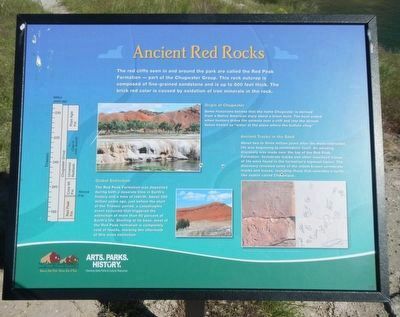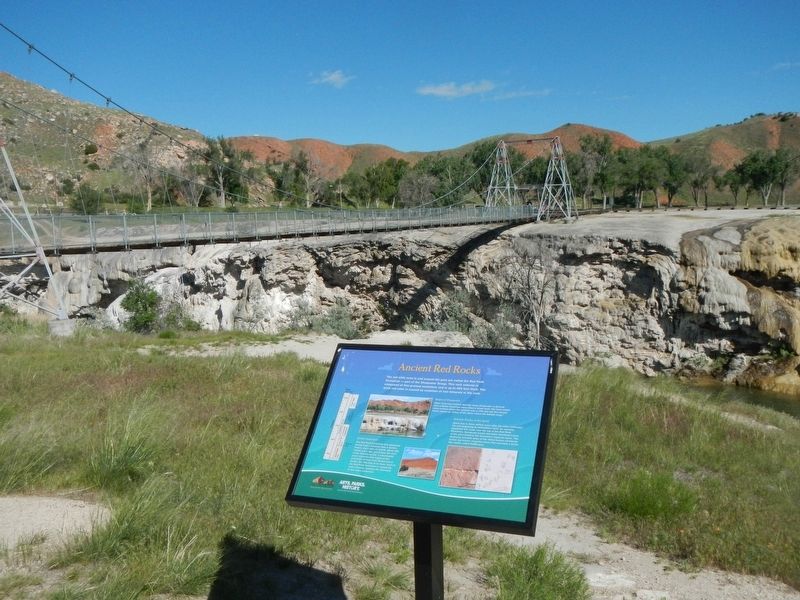Near Thermopolis in Hot Springs County, Wyoming — The American West (Mountains)
Ancient Red Rocks
Inscription.
The red cliffs seen in and around the park are called the Red Peak Formation - part of the Chugwater Group. This rock outcrop is composed of fine-grained sandstone and is up to 600 feet thick. The brick red color is caused by oxidation of iron minerals in the rock.
Origin of Chugwater
Some historians believe that the name Chugwater is derived from a Native American story about a bison hunt. The hunt ended when hunters drove the animals over a cliff and into the stream below known as "water at the place where the buffalo chug."
Global Extinction
The Red Peak Formation was deposited during both a desolate time in Earth's history and a time of rebirth. About 250 million years ago, just before the start of the Triassic period, a catastrophic event occurred that triggered the extinction of more than 90 percent of Earth's life. Starting at its base, most of the Red Peak Formation is completely void of fossils, marking the aftermath of this mass extinction.
Ancient Tracks in the Sand
About two to three million years after the mass extinction. life was beginning to reintroduce itself. An amazing discovery was made need the top of the Red Peak Formation. Vertebrate tracks and other fossilized traces of life were found in the formation's topmost layers. the discovery revealed some of the oldest known vertebrate tracks and traces, including those that resemble a turtle-like reptile called Chelonipus.
Erected by Wyoming State Parks and Cultural Resources.
Topics. This historical marker is listed in these topic lists: Natural Features • Paleontology.
Location. 43° 39.312′ N, 108° 11.826′ W. Marker is near Thermopolis, Wyoming, in Hot Springs County. Marker can be reached from Tepee Street near Big Springs Drive. Touch for map. Marker is at or near this postal address: 168 Tepee Street, Thermopolis WY 82443, United States of America. Touch for directions.
Other nearby markers. At least 8 other markers are within walking distance of this marker. 1916 Swinging Bridge (about 300 feet away, measured in a direct line); Some Like It Hot! (about 300 feet away); Geology of Hot Springs (about 500 feet away); Hot Springs State Park (about 500 feet away); Washakie's Bath House (about 600 feet away); "The Hot Springs" (about 700 feet away); Healing Waters (about 700 feet away); Tepee Fountain (approx. ¼ mile away). Touch for a list and map of all markers in Thermopolis.
More about this marker. This marker is located in Hot Springs State Park near Thermopiles, Wyoming. The swinging bridge and Big Springs trail system can be accessed from Hot Springs State Park Bathhouse on Tepee
Street. The marker is found at the northeast end of the swinging bridge.
Credits. This page was last revised on September 10, 2016. It was originally submitted on September 10, 2016, by Barry Swackhamer of Brentwood, California. This page has been viewed 569 times since then and 45 times this year. Photos: 1, 2. submitted on September 10, 2016, by Barry Swackhamer of Brentwood, California.

